中级宏观经济学曼昆英文版第七版第三章习题答案重点
宏观经济学第七版课后习题答案

宏观经济学第七版课后习题答案篇一:曼昆《宏观经济学》(第6、7版)课后习题详解(第2章宏观经济学的数据)曼昆《宏观经济学》(第6、7版)第2章宏观经济学的数据课后习题详解跨考网独家整理最全经济学考研真题,经济学考研课后习题解析资料库,您可以在这里查阅历年经济学考研真题,经济学考研课后习题,经济学考研参考书等内容,更有跨考考研历年辅导的经济学学哥学姐的经济学考研经验,从前辈中获得的经验对初学者来说是宝贵的财富,这或许能帮你少走弯路,躲开一些陷阱。
以下内容为跨考网独家整理,如您还需更多考研资料,可选择经济学一对一在线咨询进行咨询。
一、概念题 1.国内生产总值(gross domestic product,GDP)答:国内生产总值指一定时期(通常为一年)内,一个经济体生产的所有最终产品和服务的市场价值总和。
GDP一般通过支出法和收入法两种方法进行核算。
用支出法计算的国内生产总值等于消费、投资、政府购买和净出口之和;用收入法计算的国内生产总值等于工资、利息、租金、利润、间接税、企业转移支付和折旧之和。
GDP是一国范围内生产的最终产品的市场价值,因此是一个地域概念;而与此相联系的国民生产总值(GNP)则是一个国民概念,指某国国民所拥有的全部生产要素所生产的最终产品和劳务的市场价值总和。
2.国民收入核算(national income accounting)答:国民收入核算指用于衡量GDP和许多相关统计数字的核算体系,是以整个国民经济或社会再生产为对象的宏观核算。
它以一定的经济理论为指导,综合运用统计和会计的方法,对一个国家或地区在一定时期内国民经济运行过程进行系统科学的定量描述,为经济分析和国家实行宏观经济调控、制订经济政策或计划管理提供重要的客观依据。
国民经济核算一词最早出现于1941年。
荷兰经济学家范·克利夫在荷兰《经济学家》杂志1941年7月号和11月号上,先后发表两篇文章,首次使用了“国民经济核算”一词。
曼昆经济学原理第七版第三章
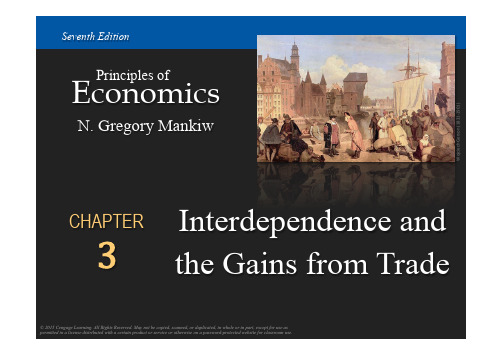
© 2015 Cengage Learning. All Rights Reserved. May not be copied, scanned, or duplicated, in whole or in part, except for use as permitted in a license distributed with a certain product or service or otherwise on a password-protected website for classroom use.
9
© 2015 Cengage Learning. All Rights Reserved. May not be copied, scanned, or duplicated, in whole or in part, except for use as permitted in a license distributed with a certain product or service or otherwise on a password-protected website for classroom use.
Wheat (tons) 5,000 4,000 3,000 2,000 1,000 0
The U.S. Without Trade
Suppose the U.S. uses half its labor to produce each of the two goods. Then it will produce and consume 250 computers and 2500 tons of wheat.
© 2015 Cengage Learning. All Rights Reserved. May not be copied, scanned, or duplicated, in whole or in part, except for use as permitted in a license distributed with a certain product or service or otherwise on a password-protected website for classroom use.
亚伯《中级宏观经济学》(第7版)课后习题详解-第3章生产率、产出和就业【圣才出品】

亚伯《中级宏观经济学》(第7版)课后习题详解-第3章生产率、产出和就业【圣才出品】第3章生产率、产出和就业一、复习题1.生产函数的定义是什么?引起一国生产函数随时间变化的因素有哪些?要了解一国所能实现的产出,除了生产函数,还需知道哪些因素?答:(1)生产函数描述了资本和劳动的使用效率,它表明了任意给定资本和劳动投入量与产出之间的关系,其一般形式为:()=,Y AF K N式中,Y为给定时期内的实际产出,A为衡量整体生产率的系数,K为资本存量,N 为给定时期内的工人数,F为产出Y与资本K和劳动N的函数关系。
(2)供给冲击或生产率冲击导致经济体生产函数的变化。
一个正向的或有利的供给冲击会增加既定资本和劳动条件下的产出。
一个负向的或不利的供给冲击会降低各资本与劳动组合下的产出。
在现实世界中,供给冲击包括天气变化、使效率提高的管理技术改善和创新、政府管制的变化。
此外,供给冲击还包括资本和劳动以外的其他投入要素的变化,这些变化同样会影响产出。
(3)除了生产函数,还需要知道经济体所拥有的资本和劳动的数量。
2.生产函数曲线是向上倾斜的,但其斜率随生产要素投入量的增加而降低。
对于生产函数的这些特性,请给出经济解释。
答:生产函数曲线向上倾向意味着任意额外投入的资本或劳动都会使得产出增加。
生产函数曲线的斜率随着生产要素投入量的增加而降低反映了要素的边际生产力递减规律,因为资本的边际产量等于生产函数曲线的斜率,资本的边际产量随着资本增加而下降,从而使得斜率随着资本投入增加而降低。
给定劳动投入数量,随着资本的增加,额外的资本增加所带来的产出增加越来越小。
3.资本的边际产量(MPK)的定义是什么?如何解释MPK曲线的形状?答:(1)资本的边际产量指每单位资本存量的增加引起的产出增加。
由于的资本K?增加引起了的产出增加,单位资本的产出增加为,因此资本的边际产量为Y?/Y K。
/Y K(2)MPK曲线可以利用生产函数曲线表示出来,给定劳动投入水平下,标出不同的资本投入带来的不同产出,就得到生产函数曲线,而MPK就是生产函数曲线的斜率。
宏观经济学第七版课后习题答案

8.国民收入核算恒等式(national income accounts identity) 答:国民收入核算恒等式指储蓄—投资恒等式,即I?S。从支出法、收入法与生产法所得出的国内生产总值的一致性,可以说明国民经济中的一个基本平衡关系。总支出代表了社会对最终产品的总需求,而总收入和总产量代表了社会对最终产品的总供给。因此,从国内生产总值的核算方法中可以得出这样一个恒等式:总需求=总供给。这种恒等关系在宏观
答:劳动力参与率是成年人口中属于劳动力的人数的百分比,用公式表示为:
劳动力参与率?劳动力?100% 成年人口
二、复习题
1.列出GDP衡量的两样东西。GDP怎么能同时衡量这两样东西呢?
答:(1)国内生产总值(GDP)主要衡量社会总收入和社会总支出,即全社会所有经济单位获得的收入总和,以及用于购买最终产品与服务的总支出。在理论上,类似于以收入法、支出法来计算GDP。
国民经济核算一词最早出现于1941年。荷兰经济学家范·克利夫在荷兰杂志1941年7月号和11月号上,先后发表两篇文章,首次使用了“国民经济核算”一词。 国民收入核算一般有三种方法:生产法、支出法和收入法,常用的为后两者。其核算的理论基础是总产出等于总收入、总产出等于总支出。
3.存量与流量(stocks and flows)
经济学中是十分重要的,可以从两部门经济入手研究国民经济的收入流量循环模型与国民经济中的恒等关系,进而研究三部门经济与四部门经济。
两部门经济中可以得出储蓄—投资恒等式:I?S。值得注意的是,这里的恒等是从国民收入核算的角度来说,就整个经济而言,事后的储蓄和事后的投资总量相等。而在分析宏观经济均衡时投资等于储蓄,是指计划投资(事前投资)等于计划储蓄(事前储蓄)所形成的经济均衡状态。
人大802考研曼昆《宏观经济学》(第7版)重点章节及重点课后习题(精细版修订版)
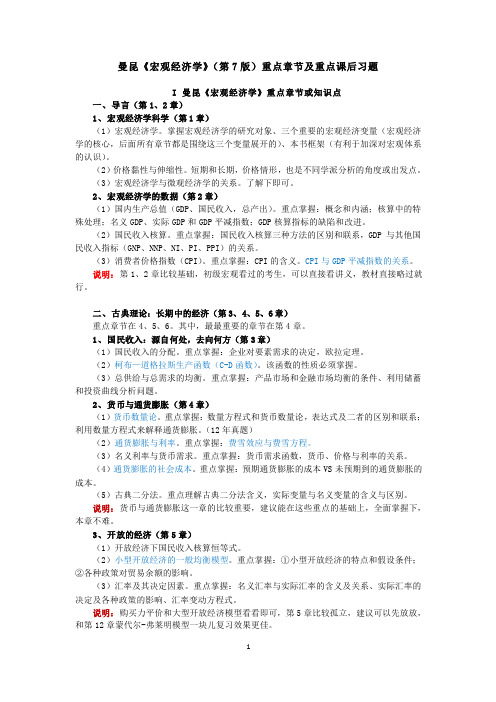
曼昆《宏观经济学》(第7版)重点章节及重点课后习题I 曼昆《宏观经济学》重点章节或知识点一、导言(第1、2章)1、宏观经济学科学(第1章)(1)宏观经济学。
掌握宏观经济学的研究对象、三个重要的宏观经济变量(宏观经济学的核心,后面所有章节都是围绕这三个变量展开的)、本书框架(有利于加深对宏观体系的认识)。
(2)价格黏性与伸缩性。
短期和长期,价格情形,也是不同学派分析的角度或出发点。
(3)宏观经济学与微观经济学的关系。
了解下即可。
2、宏观经济学的数据(第2章)(1)国内生产总值(GDP、国民收入,总产出)。
重点掌握:概念和内涵;核算中的特殊处理;名义GDP、实际GDP和GDP平减指数;GDP核算指标的缺陷和改进。
(2)国民收入核算。
重点掌握:国民收入核算三种方法的区别和联系,GDP与其他国民收入指标(GNP、NNP、NI、PI、PPI)的关系。
(3)消费者价格指数(CPI)。
重点掌握:CPI的含义。
CPI与GDP平减指数的关系。
说明:第1、2章比较基础,初级宏观看过的考生,可以直接看讲义,教材直接略过就行。
二、古典理论:长期中的经济(第3、4、5、6章)重点章节在4、5、6。
其中,最最重要的章节在第4章。
1、国民收入:源自何处,去向何方(第3章)(1)国民收入的分配。
重点掌握:企业对要素需求的决定,欧拉定理。
(2)柯布—道格拉斯生产函数(C-D函数)。
该函数的性质必须掌握。
(3)总供给与总需求的均衡。
重点掌握:产品市场和金融市场均衡的条件、利用储蓄和投资曲线分析问题。
2、货币与通货膨胀(第4章)(1)货币数量论。
重点掌握:数量方程式和货币数量论,表达式及二者的区别和联系;利用数量方程式来解释通货膨胀。
(12年真题)(2)通货膨胀与利率。
重点掌握:费雪效应与费雪方程。
(3)名义利率与货币需求。
重点掌握:货币需求函数,货币、价格与利率的关系。
(4)通货膨胀的社会成本。
重点掌握:预期通货膨胀的成本VS未预期到的通货膨胀的成本。
曼昆中级宏观经济学课后答案
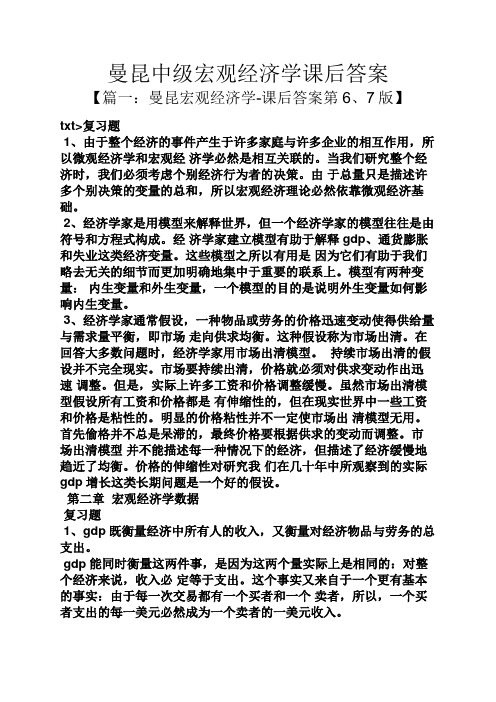
曼昆中级宏观经济学课后答案【篇一:曼昆宏观经济学-课后答案第6、7版】txt>复习题1、由于整个经济的事件产生于许多家庭与许多企业的相互作用,所以微观经济学和宏观经济学必然是相互关联的。
当我们研究整个经济时,我们必须考虑个别经济行为者的决策。
由于总量只是描述许多个别决策的变量的总和,所以宏观经济理论必然依靠微观经济基础。
2、经济学家是用模型来解释世界,但一个经济学家的模型往往是由符号和方程式构成。
经济学家建立模型有助于解释gdp、通货膨胀和失业这类经济变量。
这些模型之所以有用是因为它们有助于我们略去无关的细节而更加明确地集中于重要的联系上。
模型有两种变量:内生变量和外生变量,一个模型的目的是说明外生变量如何影响内生变量。
3、经济学家通常假设,一种物品或劳务的价格迅速变动使得供给量与需求量平衡,即市场走向供求均衡。
这种假设称为市场出清。
在回答大多数问题时,经济学家用市场出清模型。
持续市场出清的假设并不完全现实。
市场要持续出清,价格就必须对供求变动作出迅速调整。
但是,实际上许多工资和价格调整缓慢。
虽然市场出清模型假设所有工资和价格都是有伸缩性的,但在现实世界中一些工资和价格是粘性的。
明显的价格粘性并不一定使市场出清模型无用。
首先偷格并不总是呆滞的,最终价格要根据供求的变动而调整。
市场出清模型并不能描述每一种情况下的经济,但描述了经济缓慢地趋近了均衡。
价格的伸缩性对研究我们在几十年中所观察到的实际gdp增长这类长期问题是一个好的假设。
第二章宏观经济学数据复习题1、gdp既衡量经济中所有人的收入,又衡量对经济物品与劳务的总支出。
gdp能同时衡量这两件事,是因为这两个量实际上是相同的:对整个经济来说,收入必定等于支出。
这个事实又来自于一个更有基本的事实:由于每一次交易都有一个买者和一个卖者,所以,一个买者支出的每一美元必然成为一个卖者的一美元收入。
2、cpi衡量经济中物价总水平。
它表示相对于某个基年一篮子物品与劳务价格的同样一篮子物品与劳务的现期价格。
曼昆宏观经济学原理答案
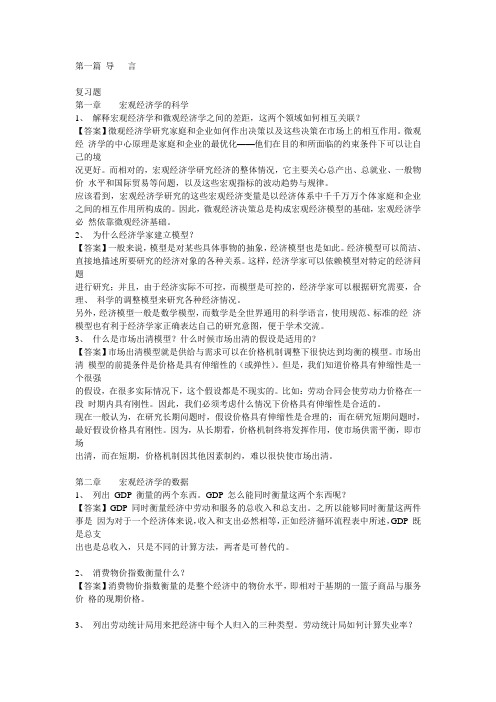
第一篇导言复习题第一章宏观经济学的科学1、解释宏观经济学和微观经济学之间的差距,这两个领域如何相互关联?【答案】微观经济学研究家庭和企业如何作出决策以及这些决策在市场上的相互作用。
微观经济学的中心原理是家庭和企业的最优化——他们在目的和所面临的约束条件下可以让自己的境况更好。
而相对的,宏观经济学研究经济的整体情况,它主要关心总产出、总就业、一般物价水平和国际贸易等问题,以及这些宏观指标的波动趋势与规律。
应该看到,宏观经济学研究的这些宏观经济变量是以经济体系中千千万万个体家庭和企业之间的相互作用所构成的。
因此,微观经济决策总是构成宏观经济模型的基础,宏观经济学必然依靠微观经济基础。
2、为什么经济学家建立模型?【答案】一般来说,模型是对某些具体事物的抽象,经济模型也是如此。
经济模型可以简洁、直接地描述所要研究的经济对象的各种关系。
这样,经济学家可以依赖模型对特定的经济问题进行研究;并且,由于经济实际不可控,而模型是可控的,经济学家可以根据研究需要,合理、科学的调整模型来研究各种经济情况。
另外,经济模型一般是数学模型,而数学是全世界通用的科学语言,使用规范、标准的经济模型也有利于经济学家正确表达自己的研究意图,便于学术交流。
3、什么是市场出清模型?什么时候市场出清的假设是适用的?【答案】市场出清模型就是供给与需求可以在价格机制调整下很快达到均衡的模型。
市场出清模型的前提条件是价格是具有伸缩性的(或弹性)。
但是,我们知道价格具有伸缩性是一个很强的假设,在很多实际情况下,这个假设都是不现实的。
比如:劳动合同会使劳动力价格在一段时期内具有刚性。
因此,我们必须考虑什么情况下价格具有伸缩性是合适的。
现在一般认为,在研究长期问题时,假设价格具有伸缩性是合理的;而在研究短期问题时,最好假设价格具有刚性。
因为,从长期看,价格机制终将发挥作用,使市场供需平衡,即市场出清,而在短期,价格机制因其他因素制约,难以很快使市场出清。
中级宏观经济学曼昆英文版第七版第三章习题答案重点
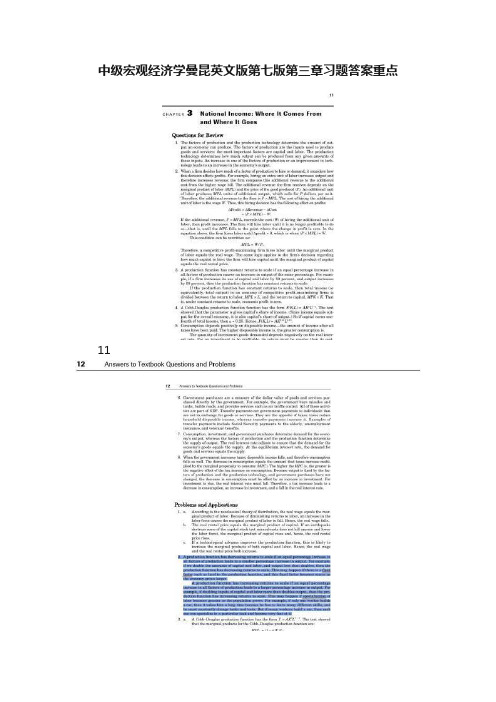
中级宏观经济学曼昆英文版第七版第三章习题答案重点11Chapter 3 National Income: Where It Comes From and Where It Goes 21 If consumption depends on the interest rate, then these conclusions about fiscal policy are modified somewhat. If consumption depends on the interest rate, then so does saving. The higher the interest rate, the greater the return to saving. Hence, it seems reasonable to think that an increase in the interest rate might increase saving and reduce consumption.Figure 3–6 shows saving as an increasing function of the interest rate. r S(r Figure 3–6 Real interest rate S Saving Consider what happens when government purchases increase. At any given level of the interest rate, national saving falls by the change in government purchases, as shown in Figure 3–7. The figure shows that if the saving function slopes upward, investment falls by less than the amount that government purchases rises by; this happens because consumption falls and saving increases in response to the higher interest rate. Hence, the more responsive consumption is to the interest rate, the less government purchases crowd out investment. r S2(r S1(r Figure 3–7 Real interest rate r1 r ?G I(r I1 II, S Investment, Saving 13. a. Figure 3–8 shows the case where the demand for loanable funds is stable but the supply of funds (the saving schedule fluctuates perhaps reflecting temporary shocks to income, changes in government spending, or changes in consumer confidence. In this case, when interest rates fall, investment rises; when interest rates rise, investment falls. We would expect a negative correlation between investment and interest rates.22 Answers to Textbook Questions and Problems S1 (r r S2 (r Figure 3–8 Real interest rate I(r I, S Investment, Saving b. Figure 3-9 shows the case where the supply of loanable funds (saving does not respond to the interest rate. Also suppose that this curve is stable, whereas the demand for loanable funds varies, perhaps reflecting fluctuations in firms’ expectations about the marginal product of capital. We would now fin d a positive correlation between investment and the interest rate—when demand for funds rises, this pushes up the interest rate, so we see investment increase and the real interest rate increase at thesame time. r S(r Figure 3–9 Real interest rate I 2 (r I 1 (r I, S Investment, SavingChapter 3 National Income: Where It Comes From and Where It Goes 23 c. If both curves shift, we might generate a scatter plot as in Figure 3–10, where the economy fluctuates among points A, B, C, and D. Depending on how often the economy is at each of these points, we might find little clear relationship between investment and interest rates. r S1 (r S2 (r D Real interest rate C A Figure 3–10 B I 1 (r I 2 (r I, S Investment, Saving d. Situation (c seems fairly reasonable—both the supply of and demand for loanable funds fluctuate over time in response to changes in the economy.。
(完整)经济学原理第7版(曼昆)宏观经济学复习重点
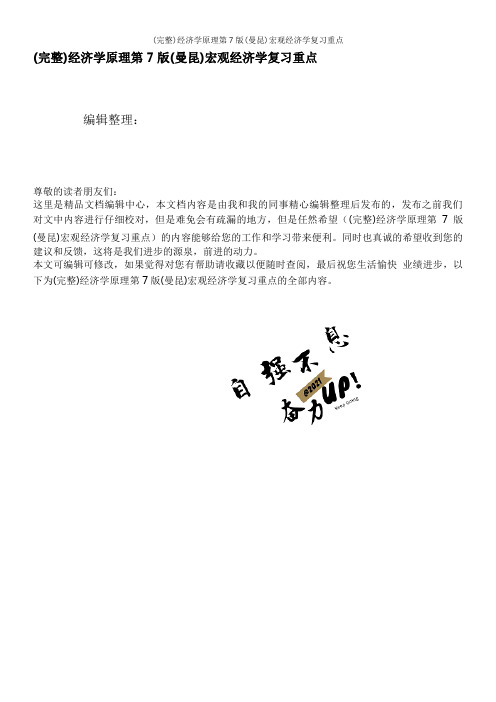
(完整)经济学原理第7版(曼昆)宏观经济学复习重点编辑整理:尊敬的读者朋友们:这里是精品文档编辑中心,本文档内容是由我和我的同事精心编辑整理后发布的,发布之前我们对文中内容进行仔细校对,但是难免会有疏漏的地方,但是任然希望((完整)经济学原理第7版(曼昆)宏观经济学复习重点)的内容能够给您的工作和学习带来便利。
同时也真诚的希望收到您的建议和反馈,这将是我们进步的源泉,前进的动力。
本文可编辑可修改,如果觉得对您有帮助请收藏以便随时查阅,最后祝您生活愉快业绩进步,以下为(完整)经济学原理第7版(曼昆)宏观经济学复习重点的全部内容。
第23章1.对于一个整体经济而言,收入必定等于支出2.国内生产总值(GDP)在某一既定时期一个国家内生产的所有最终物品和劳务的市场价值。
GDP通常是一年或一个季度(3个月);衡量的生产价值局限于一个国家的地理范围之内,不管是由本国的国民还是住在本国的外国人生产;只包括现期生产的物品,不包括过去生产的物品;生产并合法出售的所有东西;只包括最终物品的价值;包括有形的物品,也包括无形的劳务;使用市场价格。
3。
GDP 的四个组成部分是消费(C )、投资(I )、政府购买(G )和净出口(NX ).(1)消费是家庭除购买新住房之外用于物品与服务的支出(2)投资是用于资本设备、存货和建筑物的支出,包括家庭用于购买新住房的支出(3)政府购买包括地方、州和联邦政府用于物品与服务的支出(4)净出口等于外国对国内生产的物品的购买(出口)减国内对外国物品的购买(进口)国内生产总值等于消费、投资、政府支出和净出口之和4. 真实GDP和名义GDP真实GDP:按不变价格评价的物品与服务的生产(是用不变的基年价格来评价经济中物品与服务生产的价值)不受价格变动的影响,反映产的产量的变动名义GDP:按现期价格评价的物品与服务的生产(是用当年价格来评价经济中物品与服务生产的价值)GDP 平减指数GDP 平减指数是用名义GDP与真实GDP的比率乘以100计算的物价水平衡量指标即GDP平减指数= (名义GDP/真实GDP)*100通货膨胀率=[(第2年的GDP平减指数—第一年的GDP平减指数)/第一年的GDP平减指数]*100第24章1.消费物价指数CPI答:指普通消费者购买的物品与服务的总费用的衡量指标。
曼昆宏观经济学第七版中文答案
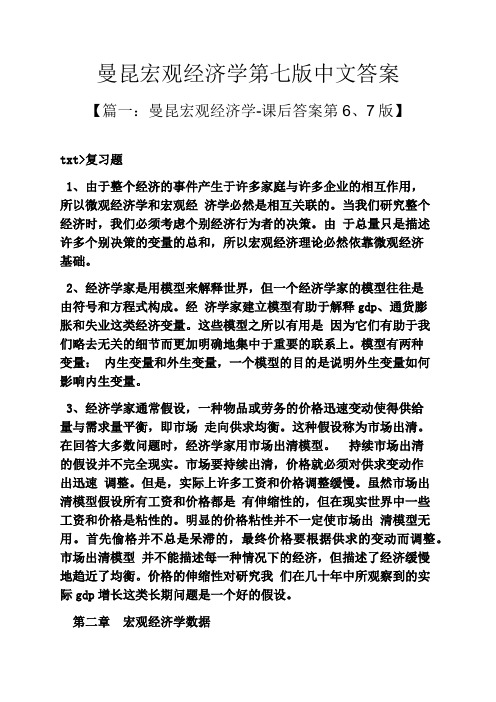
曼昆宏观经济学第七版中文答案【篇一:曼昆宏观经济学-课后答案第6、7版】txt>复习题1、由于整个经济的事件产生于许多家庭与许多企业的相互作用,所以微观经济学和宏观经济学必然是相互关联的。
当我们研究整个经济时,我们必须考虑个别经济行为者的决策。
由于总量只是描述许多个别决策的变量的总和,所以宏观经济理论必然依靠微观经济基础。
2、经济学家是用模型来解释世界,但一个经济学家的模型往往是由符号和方程式构成。
经济学家建立模型有助于解释gdp、通货膨胀和失业这类经济变量。
这些模型之所以有用是因为它们有助于我们略去无关的细节而更加明确地集中于重要的联系上。
模型有两种变量:内生变量和外生变量,一个模型的目的是说明外生变量如何影响内生变量。
3、经济学家通常假设,一种物品或劳务的价格迅速变动使得供给量与需求量平衡,即市场走向供求均衡。
这种假设称为市场出清。
在回答大多数问题时,经济学家用市场出清模型。
持续市场出清的假设并不完全现实。
市场要持续出清,价格就必须对供求变动作出迅速调整。
但是,实际上许多工资和价格调整缓慢。
虽然市场出清模型假设所有工资和价格都是有伸缩性的,但在现实世界中一些工资和价格是粘性的。
明显的价格粘性并不一定使市场出清模型无用。
首先偷格并不总是呆滞的,最终价格要根据供求的变动而调整。
市场出清模型并不能描述每一种情况下的经济,但描述了经济缓慢地趋近了均衡。
价格的伸缩性对研究我们在几十年中所观察到的实际gdp增长这类长期问题是一个好的假设。
第二章宏观经济学数据复习题1、gdp既衡量经济中所有人的收入,又衡量对经济物品与劳务的总支出。
、gdp能同时衡量这两件事,是因为这两个量实际上是相同的:对整个经济来说,收入必定等于支出。
这个事实又来自于一个更有基本的事实:由于每一次交易都有一个买者和一个卖者,所以,一个买者支出的每一美元必然成为一个卖者的一美元收入。
2、cpi衡量经济中物价总水平。
它表示相对于某个基年一篮子物品与劳务价格的同样一篮子物品与劳务的现期价格。
中级宏观经济学曼昆英文版第七版第三章习题答案
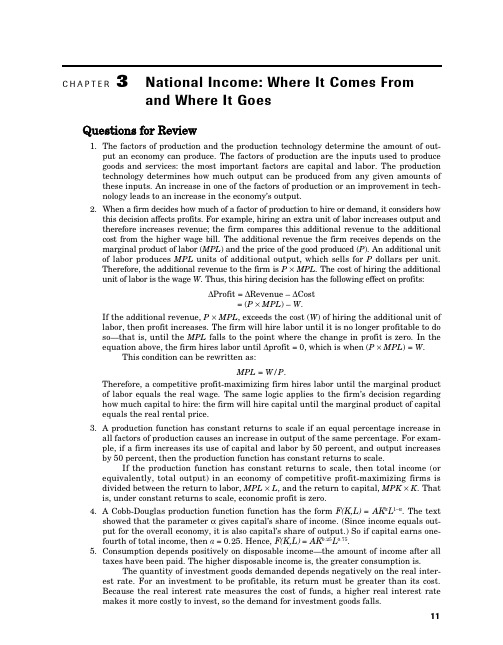
3
National Income: Where It Comes From and Where It Goes
Questions for Review
1. The factors of production and the production technology determine the amount of output an economy can produce. The factors of production are the inputs used to produce goods and services: the most important factors are capital and labor. The production technology determines how much output can be produced from any given amounts of these inputs. An increase in one of the factors of production or an improvement in technology leads to an increase in the economy’s output. 2. When a firm decides how much of a factor of production to hire or demand, it considers how this decision affects profits. For example, hiring an extra unit of labor increases output and therefore increases revenue; the firm compares this additional revenue to the additional cost from the higher wage bill. The additional revenue the firm receives depends on the marginal product of labor (MPL) and the price of the good produced (P). An additional unit of labor produces MPL units of additional output, which sells for P dollars per unit. Therefore, the additional revenue to the firm is P × MPL. The cost of hiring the additional unit of labor is the wage W. Thus, this hiring decision has the following effect on profits: ∆Profit = ∆Revenue – ∆Cost = (P × MPL) – W. If the additional revenue, P × MPL, exceeds the cost (W) of hiring the additional unit of labor, then profit increases. The firm will hire labor until it is no longer profitable to do so—that is, until the MPL falls to the point where the change in profit is zero. In the equation above, the firm hires labor until ∆profit = 0, which is when (P × MPL) = W. This condition can be rewritten as: MPL = W/P. Therefore, a competitive profit-maximizing firm hires labor until the marginal product of labor equals the real wage. The same logic applies to the firm’s decision regarding how much capital to hire: the firm will hire capital until the marginal product of capital equals the real rental price. 3. A production function has constant returns to scale if an equal percentage increase in all factors of production causes an increase in output of the same percentage. For example, if a firm increases its use of capital and labor by 50 percent, and output increases by 50 percent, then the production function has constant returns to scale. If the production function has constant returns to scale, then total income (or equivalently, total output) in an economy of competitive profit-maximizing firms is divided between the return to labor, MPL × L, and the return to capital, MPK × K. That is, under constant returns to scale, economic profit is zero. 4. A Cobb-Douglas production function function has the form F(K,L) = AKαL1–α. The text showed that the parameter α gives capital’s share of income. (Since income equals output for the overall economy, it is also capital’s share of output.) So if capital earns onefourth of total income, then a = 0.25. Hence, F(K,L) = AK0.25L0.75. 5. Consumption depends positively on disposable income—the amount of income after all taxes have been paid. The higher disposable income is, the greater consumption is. The quantity of investment goods demanded depends negatively on the real interest rate. For an investment to be profitable, its return must be greater than its cost. Because the real interest rate measures the cost of funds, a higher real interest rate makes it more costly to invest, so the demand for investment goods falls. 11
宏观经济学第七版课后习题答案
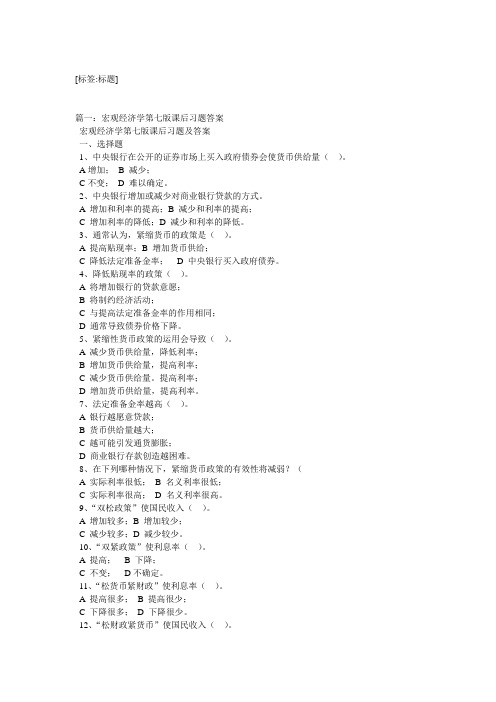
[标签:标题]篇一:宏观经济学第七版课后习题答案宏观经济学第七版课后习题及答案一、选择题1、中央银行在公开的证券市场上买入政府债券会使货币供给量()。
A增加;B 减少;C不变;D 难以确定。
2、中央银行增加或减少对商业银行贷款的方式。
A 增加和利率的提高;B 减少和利率的提高;C 增加利率的降低;D 减少和利率的降低。
3、通常认为,紧缩货币的政策是()。
A 提高贴现率;B 增加货币供给;C 降低法定准备金率;D 中央银行买入政府债券。
4、降低贴现率的政策()。
A 将增加银行的贷款意愿;B 将制约经济活动;C 与提高法定准备金率的作用相同;D 通常导致债券价格下降。
5、紧缩性货币政策的运用会导致()。
A 减少货币供给量,降低利率;B 增加货币供给量,提高利率;C 减少货币供给量。
提高利率;D 增加货币供给量,提高利率。
7、法定准备金率越高()。
A 银行越愿意贷款;B 货币供给量越大;C 越可能引发通货膨胀;D 商业银行存款创造越困难。
8、在下列哪种情况下,紧缩货币政策的有效性将减弱?(A 实际利率很低;B 名义利率很低;C 实际利率很高;D 名义利率很高。
9、“双松政策”使国民收入()。
A 增加较多;B 增加较少;C 减少较多;D 减少较少。
10、“双紧政策”使利息率()。
A 提高;B 下降;C 不变;D不确定。
11、“松货币紧财政”使利息率()。
A 提高很多;B 提高很少;C 下降很多;D 下降很少。
12、“松财政紧货币”使国民收入()。
A 增加;B 减少;C 不变;D不确定。
二、名词解释1、中央银行的贴现率)2、公开市场业务3、简单货币规则的内容三、简答题1、中央银行控制货币供给量的工具是什么?2、宏观经济政策的目标是什么?为达到这些目标可采用的政策工具有哪些?3、财政政策与货币政策有何区别?四、论述题1、扩张财政对萧条经济会产生怎样的影响?2、为什么在凯恩斯陷阱区扩张性财政的产出效应最大?参考答案一、选择题1、A,2、B,3、A,4、A,5、C,6、D,7、A,8、A,9、D,10、C,11、D。
曼昆宏观经济学英语课后题答案

CHAPTER 23: MEASURING A NATION’S INCOMETrue/FalseIndicate whether the statement is true or false.1. T he circular flow diagram describes all transactions between households and firms in a simpleeconomy and shows the equality of expenditures and income.ANSWER: TPOINTS: 0 / 12. G ross domestic product includes most items produced and sold illicitly.ANSWER: FPOINTS: 0 / 13. N et national product is the total in come of a nation’s residents minus losses from depreciation.ANSWER: TPOINTS: 0 / 14. D isposable personal income is the income that households and unincorporated business haveleft after satisfying all their obligations to the government. It equals personal income minuspersonal taxes and certain non-tax payments to government.ANSWER: TPOINTS: 0 / 15. T he purchase of new houses by households is included in the calculation of personalconsumption expenditures of GDP.ANSWER: FPOINTS: 0 / 1Multiple ChoiceIdentify the choice that best completes the statement or answers the question.1. W hen GDP falls,a. income and expenditure must both fall.b. income and expenditure can both rise.c. income must fall, but expenditure may rise or fall.d. expenditure must fall, but income may rise or fall.ANSWER: APOINTS: 0 / 12. I ncome equals expenditure becausea. firms always pay out all their revenue as income to someone.b. each time a sale is made, there is a buyer and a seller.c. households own the factors of production used to generate incomes.d. All of the above are correct.ANSWER: BPOINTS: 0 / 13. I f a province makes the production and sale of illicit drugs legal, then GDPa. must increase.b. must decrease.c. wouldn't change.d. may increase or decrease.ANSWER: APOINTS: 0 / 14. W hen a government provides subsidies to encourage growth of small businesses, the subsidieswoulda. be included in GDP because they are invested by businesses.b. be included in GDP because they are a form of government spending.c. not be included in GDP because they are transfer payments.d. may or may not be included in GDP, depending on how the funds are used.ANSWER: CPOINTS: 0 / 15. D iesel fuel isa. always considered a final good.b. counted as an intermediate good if a company uses it to provide transportation services.c. counted as a final good if a farmer uses it to run a tractor to grow crops.d. Both b and c are correct.ANSWER: BPOINTS: 0 / 16. G ross domestic producta. is the market value of all final goods and services produced within a country in a givenperiod (usually a year)b. is the income in the hands of individuals after deducting income taxes; income availableto households to spend and savec. is the value of goods and services purchased by all levels of government— federal,provincial, and local—in a given periodd. is the market value of all final goods and services produced by permanent residents of anation in a given time periodANSWER: APOINTS: 0 / 17. M acroeconomics is that branch of economics that studiesa. the conditions of individual marketsb. the influence of governments on individual marketsc. economy-wide phenomenad. only the private sector of the economyANSWER: CPOINTS: 0 / 18. S uppose that nominal GDP is $6,000 billion and real GDP is $3,000. What is the GDP pricedeflator?a. 125b. 150c. 200d. 250ANSWER: CPOINTS: 0 / 19. T he purchase of final goods and services by households is calleda. investmentb. public sector expenditurec. consumptiond. net exportsANSWER: CPOINTS: 0 / 110. I nvestment is the purchase of capital equipment, inventories, anda. structuresb. non-durable goodsc. depreciationd. import investmentANSWER: APOINTS: 0 / 111. T ransfer paymentsa. are included in GDP because they are forms of incomeb. are included in GDP because goods and services have been produced in the transferc. are NOT included in the GDP because goods and services have not been produced inthe transferd. are included in GDP because they represent the production of transfers of goods andservices to foreign countriesANSWER: CPOINTS: 0 / 112. W hich of the following would be considered consumption expenditure?a. The Smiths buy a home built in 1990.b. The federal government pays the salary of a captain in the Armed Forces.c. The Hostlers buy a new car that was manufactured in Germany.d. The government buys food for its armed forces.ANSWER: CPOINTS: 0 / 113. T he method that measures GDP in relationship to the size of the population is calleda. GNPb. worker GDPc. GDP per persond. capital GDPANSWER: CPOINTS: 0 / 114. T he components of GDP area. C + I + Gb. NX + G + Cc. C + G + NXd. C + I + G + NXANSWER: DPOINTS: 0 / 115. S uppose nominal GDP is $7700 and the GDP deflator is 110. Real GDP isa. $7700b. $7000c. $847,000d. $8470ANSWER: BPOINTS: 0 / 1Short Answer1. W hat are the components of gross domestic product (GDP)?RESPONSE:ANSWER: The components of GDP are: (1) consumption spending by households on goods and services, with the exception of purchases of new housing; (2) Investmentspending on capital equipment, inventories, and structures, including householdpurchases of new housing; (3) government purchases or spending on goods andservices by the local, provincial, and federal levels governments; and (4) netexports which is spending on domestically produced goods and services byforeigners (exports) minus spending on foreign goods and services by domesticresident (imports).POINTS: -- / 12. D ifferentiate between gross domestic product (GDP) and gross national product (GNP).RESPONSE:ANSWER: GDP is the value of all final goods and services produced within a country in a given year; while GNP is the total income earned by a nation’s permanent residents ornationals (that is, Canadians). GNP differs from GDP by including income thatcitizens of the nation (Canada) earned aboard, and excluding income thatforeigners earn in the particular country (E.g. in Canada).POINTS: -- / 13. D ifferentiate between real GDP and nominal GDP.RESPONSE:ANSWER: Nominal GDP is the value of all final goods and services produced within a country in a year and valued at current prices; and real GDP is the GDP valued at constantbase year prices. Real GDP is not affected by changes in the level of prices, so itreflects only changes in the amounts being produced.POINTS: -- / 14. E xplain why GDP is not considered a perfect measure of well- being?RESPONSE:ANSWER: GDP is not considered a perfect measure of well-being because some of thefactors that contribute to a good life are omitted. These would include: leisure time,the quality of the environment, the distribution of income, and the production ofgoods and services that did not pas through the market (for example, houseworkdone by the homemaker, and volunteer work)POINTS: -- / 15. H ow do economists measure economic growth?RESPONSE:ANSWER: Economists measure economic growth as the percentage change in real GDP from one period to another. This is because changes in real GDP reflect only changes inthe amounts being produced.POINTS: -- / 1CHAPTER 24: MEASURING THE COST OF LIVINGTrue/FalseIndicate whether the statement is true or false.1. T he GDP deflator reflects the prices of goods and services bought by consumers, and the consumerprice index reflects the price of all final goods and services produced domestically.ANSWER: FPOINTS: 0 / 12. T he consumer price index compares the price of a fixed basket of goods and services to the price ofthe basket in the base year. On the other hand, the GDP deflator compares the price of currently produced goods and services to the price of the same goods and services in the base years.ANSWER: TPOINTS: 0 / 13. I ndexation refers to the automatic correction of a dollar amount for the effects of inflation by law orcontract.ANSWER: TPOINTS: 0 / 14. L ong term contracts between firms and unions will sometimes include partial or complete indexationof the wage to the consumer price index. This is called a cost-of-living allowance clause.ANSWER: TPOINTS: 0 / 15. T he core inflation rate is the consumer price index with the exclusion of the most volatilecomponents such as energy and food.ANSWER: TPOINTS: 0 / 1Multiple ChoiceIdentify the choice that best completes the statement or answers the question.1. I n the CPI, goods and services are weighted according toa. how much a typical consumer buys of each item.b. whether the items are necessities or luxuries.c. how much of each item is produced in the domestic economy.d. how much is spent on them in the national income accounts.ANSWER: APOINTS: 0 / 12. B y not taking into account the possibility of consumer substitution, the CPIa. understates the standard of living.b. overstates the cost of living.c. neither overstates nor understates the cost of living.d. doesn't accurately reflect the cost of living, but it is unclear if it overstates or understates thecost of living.ANSWER: BPOINTS: 0 / 13. I f the prices of Brazilian-made shoes imported into Canada increases, thena. both Canada’s GDP deflator and it’s consumer price index will increase.b. neither Canada’s GDP deflator nor it’s consumer pri ce index will increase.c. Canada’s GDP deflator will increase but its CPI will not increase.d. Canada’s consumer price index will increase, but its GDP deflator won’t change.ANSWER: DPOINTS: 0 / 14. I f increases in the prices of Canadian car insurance causes the CPI to increase by 3 percent, theGDP deflator will likely increase bya. more than 3 percent.b. 3 percent.c. less than 3 percent.d. All of the above are correct.ANSWER: CPOINTS: 0 / 15. T he real interest rate tells youa. how quickly your savings account will grow.b. how quickly the purchasing power of your savings account will grow.c. the size of your savings account.d. the purchasing power of your savings account.ANSWER: BPOINTS: 0 / 16. I nflation refers toa. a temporary increase in the price level due to higher tax ratesb. a large increase in food and gasoline pricesc. a situation in which the economy's overall price level is risingd. an increase in the purchasing power of the dollarANSWER: CPOINTS: 0 / 17. I f nominal interest rates increase from 8 percent to 10 percent while inflation increases from 3percent to 12 percenta. the real interest rate falls from 5 percent to –2 percentb. the real interest rate rises from –2 percent to 5 percentc. the real interest rate falls from 8 percent to 12 percentd. the real interest rate rises from 8 percent to 12 percentANSWER: APOINTS: 0 / 18. I f the nominal rate of interest is 10 percent and the rate of inflation is 3 percent, what is the real rateof interest?a. 13 percentb. 7 percentc. 3 percentd. –7 percentANSWER: BPOINTS: 0 / 19. T he consumer price index:a. measures price changes of raw materialsb. adjusts all prices of goods and services for five-year periodsc. measures the cost of goods and services bought by a typical consumerd. cannot measure price changes of intangible production such as servicesANSWER: CPOINTS: 0 / 110. I f the consumer price index (CPI) at the end of 1996 was 125 and the CPI at the end of 1997 was131, then the rate of inflation during 1997 wasa. zero – prices were stable during 1997b. 4.8 percentc. 6.0 percentd. 125 percentANSWER: BPOINTS: 0 / 111. F rank's nominal income in 1998 is $45,000. Suppose the CPI in 1998 is 150. What is Frank's realincome?a. $51,750b. $45,000c. $38,250d. $30,000ANSWER: DPOINTS: 0 / 112. A change in the price of imports bought by consumers will bea. reflected in the GDP deflatorb. reflected in GDPc. reflected in the CPId. reflected in net national incomeANSWER: CPOINTS: 0 / 113. A ll of the following but one are problems associated with the CPIa. substitution biasb. the introduction of new goods and servicesc. unmeasured quality changesd. The CPI is not based on a fixed basket of goods and servicesANSWER: DPOINTS: 0 / 114. W hich of the following is correct?a. The CPI is not based on a fixed basket of goods and services.b. The GDP deflator reflects the prices of all domestically produced goods and services.c. The GDP deflator is based on a fixed basket of goods and services.d. The GDP deflator is subject to substitution bias.ANSWER: BPOINTS: 0 / 115. T he inflation ratea. is a measure of the cost of a basket of goods and services bought by firmsb. is the absolute change in prices between yearsc. is the percentage change in the price index from the preceding periodd. measures changes in incomes from one year to the nextANSWER: CPOINTS: 0 / 1Short Answer1. W hat is the consumer price index (CPI)? What are the three major items included in the CPI?RESPONSE:ANSWER: The CPI is a measure of the overall cost of the goods and services bought by a typical consumer. The three major items included in the CPI are shelter, transportation andfood.POINTS: -- / 12. H ow is the CPI computed?RESPONSE:ANSWER: First the basket of goods and services must be determined and also the relative importance of the various items to be included in the basket. Then the prices of thevarious items in the basket are determined. The cost of the basket is then determinedusing the data on prices and quantity. The base year is chosen, and the index for thebase year is computed using the quantities in the basket and the base year prices.The index is calculated by taking the price of the basket in the each year and dividingthis by the price of the basket in the base year. This ratio is then multiplied by 100. POINTS: -- / 13. D ifferentiate between the nominal rate of interest and the real rate of interest.RESPONSE:ANSWER: The nominal interest rate is the interest rate as usually reported without a correction for the effects of inflation. The real interest rate is the interest rate corrected for theeffects of inflation. The real interest rate = nominal interest rate minus the inflationrate.POINTS: -- / 14. W hat is meant by the inflation rate? If the CPI in 1996 was 107.6 and in 1995 was 105.9, calculatethe inflation rate for 1996.RESPONSE:ANSWER: The inflation rate is the percentage change in the price index from the preceding period. The inflation rate for 1996 would be:POINTS: -- / 15. W hat are the problems associated with using the consumer price index to measure the cost ofliving?RESPONSE:ANSWER: The problems are: (1) Prices do not change proportionately. Consumers respond by buying less of the goods whose prices have risen by large amounts and by buyingmore of the goods whose price have risen by less, or even fallen. The index iscomputed using a fixed basket of items, so theses changes in quantity would not bereflected in the basket. This is referred to as the substitution bias. (2) The CPI isdeveloped using a fixed basket of goods and services, when new products areintroduced during the time period that a particular fixed basket is being used, thesenew products will not be included in calculation of the index. (3) The CPI does notmeasure quality changes. If the quality of a good deteriorates from one year to thenext, the value of the dollar falls, even if the price of the good stays the same.Likewise, if the quality of the good increases from one year to the next, the value of adollar also rises. Statistics Canada will try to adjust the price of the good to account forthe quality change, but it is very difficult to measure quality.POINTS: -- / 1CHAPTER 25: PRODUCTION AND GROWTHTrue/FalseIndicate whether the statement is true or false.1. O ne way to raise future productivity is to invest less current resources in the production of capital.ANSWER: FPOINTS: 0 / 12. D iminishing returns occur when the benefits from an extra unit of output declines as the quantityof output declines.ANSWER: FPOINTS: 0 / 13. M althusian theory states that an ever-increasing population would continually strain society’sability to provide for itself. This doomed human beings to forever live in poverty.ANSWER: TPOINTS: 0 / 14. P roductivity growth is measured by real output per worker.ANSWER: TPOINTS: 0 / 15. T he primary reason that living standards are higher today than they were a century ago is thattechnological knowledge has advanced.ANSWER: TPOINTS: 0 / 1Multiple ChoiceIdentify the choice that best completes the statement or answers the question.1. O f the following countries, which grew the slowest over the last 100 years?a. Brazil.b. Mexico.c. Singapore.d. United States.ANSWER: DPOINTS: 0 / 12. O n average, each year of schooling raises a person's wage in Canada by abouta. 3 percent.b. 10 percent.c. 15 percent.d. 25 percent.ANSWER: BPOINTS: 0 / 13. T he primary reason that Canadian living standards are higher today than they were a century agois thata. more productive natural resources have been discovered.b. physical capital per worker has increased.c. technological knowledge has increased.d. human capital has increased.ANSWER: CPOINTS: 0 / 14. M any countries in Africa have low growth rates. This is partly due toa. few natural resourcesb. high trade barriers.c. low incomes, making it very difficult for them to grow.d. All of the above are correct.ANSWER: BPOINTS: 0 / 15. A government can encourage growth and, in the long run, raise the economy’s standard of livingby encouraginga. population growth.b. consumption spending.c. saving and investment.d. trade restrictions.ANSWER: CPOINTS: 0 / 16. D iminishing returns is the notion thata. as the stock of capital ages, the extra output produced decreasesb. as the stock of capital is increased, the extra output produced from an additional unit ofcapital fallsc. as resources are used to produce capital goods, fewer additional capital goods can beproducedd. you always get what you pay forANSWER: BPOINTS: 0 / 17. C ompared with richer countries, poorer countries are generally characterized bya. high real GDP per personb. political stabilityc. rapid population growthd. strongly enforced property rightsANSWER: CPOINTS: 0 / 18. W hich one of the following countries would most likely be considered a poorer nation, using realGDP/person?a. Canadab. Germanyc. Japand. IndiaANSWER: DPOINTS: 0 / 19. W hich of the following factors would be most likely to encourage capital formation in a poorernation?a. the expectation of sustained high rates of inflation in the futureb. the expectation that property rights will remain securec. the expectation that a struggle between capitalist and socialist forces will lead to majorstructural change in the economyd. an increase in corporate taxes in order to finance an expanded government welfareprogramANSWER: BPOINTS: 0 / 110. W hich of the following is most likely to cause the productivity of labour to increase?a. higher money wage ratesb. a higher rate of investment in human and physical capitalc. more flexible working hours and improved retirement plansd. none of the aboveANSWER: BPOINTS: 0 / 111. S uppose that factory output rose from 50,000 units to 55,000 units while labour hours rose from1100 to 1200. Which of the following is true?a. Labour productivity remained unchanged.b. Labour productivity increased slightly.c. Labour productivity decreased slightly.d. Labour productivity increased sharply.ANSWER: BPOINTS: 0 / 112. W hich of the following would be most likely to cause the real income per person of poorercountries to rise?a. a more rapid population growthb. a rapid rate of inflationc. an international minimum-wage lawd. an increase in foreign investment that enhanced the productivity of the labour forceANSWER: DPOINTS: 0 / 113. I f a production function has constant returns to scale, then:a. doubling inputs will double output.b. doubling inputs will triple output.c. doubling inputs will cause output to increase, but the increase in output will be less thanthe increase in inputs.d. doubling inputs will decrease output.ANSWER: APOINTS: 0 / 114. T he most important source of rising living standards over time is:a. the increase in the size of the labour force.b. the increase in the labour force participation rate.c. the increase in productivity.d. the increase in human capital—the skills embodied in the work force.ANSWER: CPOINTS: 0 / 1Short Answer1. W hat is productivity and why is it important?RESPONSE:ANSWER: Productivity is the amount of goods and services produced from each hour of a worker’s time. It is the major determinant of the standard of livi ng of a country.POINTS: -- / 12. H ow is productivity determined?RESPONSE:ANSWER: Productivity is determined by a country’s physical capital, human capital, natural resources and technological knowledge.POINTS: -- / 13. W hat is the World Bank and what are its functions?RESPONSE:ANSWER: The World Bank is an international organization that among other thingsencourages the flow of capital to poor countries. It obtains funds from the world’sadvance counties and loans them to less developed countries so that they caninvest in capital infrastructure. The World Bank offers advice to developingcountries on how the funds might best be used.POINTS: -- / 14. W hat are property rights? What role does property rights play in economic growth?RESPONSE:ANSWER: Property rights refer to the ability of people to exercise authority over the resources they own. There must be an economy-wide respect for property rights for the pricesystem or the free market to work. Lack of respect for property rights or theenforcement of property rights would not only cause political instability but wouldalso discourage savings and investment. These are necessary for economicgrowth.POINTS: -- / 15. D ifferentiate between inward-oriented policies and outward-oriented policies.RESPONSE:ANSWER: Inward-oriented policies are aimed at raising productivity and living standards withina county by avoiding interaction with the rest of the world. This approach involvesthe protection of domestic industries to allow them to develop and grow withoutcompetition from foreign firms. Outward-oriented policies are designed to integratecountries into the world economy as international trade is considered to be a factorin generating economic growth.POINTS: -- / 1CHAPTER 26: SAVING, INVESTMENT, AND THE FINANCIAL SYSTEMTrue/FalseIndicate whether the statement is true or false.1. P rivate savings are the tax revenue that the government has left after paying for its spending; andpublic savings is the income that households have left after paying for taxes and consumption.ANSWER: FPOINTS: 0 / 12. A budget deficit is an excess of tax revenue over government spending; and a budget surplus is ashortfall of tax revenue from government spending.ANSWER: FPOINTS: 0 / 13. A budget surplus decreases the supply of loanable funds, increases the interest rate, andstimulates investment.ANSWER: FPOINTS: 0 / 14. T he financial system is the group of institutions in the economy that help to match one person’ssavings with another person’s investment.ANSWER: TPOINTS: 0 / 15. A mutual fund is an institution that sells shares to the public and uses the proceeds to buy aselection, or portfolio, of various types of stocks, bonds, or both stocks and bonds.ANSWER: TPOINTS: 0 / 1Multiple ChoiceIdentify the choice that best completes the statement or answers the question.1. W hich of the following is correct?a. Lenders buy bonds and borrowers sell them.b. Long-term bonds usually pay a lower interest rate than do short-term bonds becauselong-term bonds are riskier.c. Junk bonds refer to bonds that have been resold many times.d. None of the above are correct.ANSWER: APOINTS: 0 / 12. I n a closed economy, national saving equalsa. investment.b. income minus the sum of consumption and government expenditures.c. private saving plus public saving.d. All of the above are correct.ANSWER: DPOINTS: 0 / 13. I f the current market interest rate for loanable funds is below the equilibrium level, then there is aa. shortage of loanable funds and the interest rate will rise.b. surplus of loanable funds and the interest rate will rise.c. shortage of loanable funds and the interest rate will fall.d. surplus of loanable funds and the interest rate will fall.ANSWER: APOINTS: 0 / 14. S uppose that Parliament were to introduce a new investment tax credit. What would happen in themarket for loanable funds?a. The demand for loanable funds would shift left and interest rates fall.b. The demand for loanable funds would shift right and interest rates rise.c. The supply of loanable funds would shift left and interest rates rise.d. The supply of loanable funds would shift right and interest rates fall.ANSWER: BPOINTS: 0 / 15. I f Canada increases its budget deficit, it will reducea. private saving and so shift the supply of loanable funds left.b. investment and so shift the demand for loanable funds left.c. public saving and so shift the supply of loanable funds left.d. None of the above are correct.ANSWER: CPOINTS: 0 / 16. C rowding out refers toa. the increase in national saving that occurs when government runs a deficitb. the decrease in the real interest rates due to government borrowingc. a reduction in investment spending resulting from government borrowingd. a decrease in consumption spending resulting from government borrowingANSWER: CPOINTS: 0 / 17. F or a bank to be profitable, the loans it makes must _____ than the _____ obtaining funds.a. cost more; price ofb. pay less interest; total revenue fromc. make more interest; total cost ofd. be less profitable; total revenue fromANSWER: CPOINTS: 0 / 18. L arge budget deficits will likelya. increase the nation's pool of savingb. decrease the nation's pool of savingc. have no impact on the nation's pool of savingd. improve the nation's trade balanceANSWER: BPOINTS: 0 / 19. T he supply curve of loanable funds isa. upward-sloping, reflecting the fact that savers need a higher rate of interest to coax theminto lending moreb. downward-sloping, reflecting the fact that savers will increase their supply for loanablefunds at lower rates of interestc. upward-sloping, reflecting the fact that savers will increase their saving at lower rates ofinterestd. None of the aboveANSWER: APOINTS: 0 / 1。
曼昆版经济学原理(宏观经济学分册)第七版课后题及答案

曼昆版经济学原理(宏观经济学分册)第七版课后题及答案1下列每种交易会影响CDP的哪一部分(如果有影响的话)?并解释之。
A.家庭购买了一台新冰箱。
答:家庭购买了一台新冰箱会增加GDP中的消费(C)部分,因为家庭用于家用电器的支出计算在消费的耐用品类中。
B.杰妮姑妈买了一所新房子。
答:杰妮姑妈买了一所新房子会增加GDP中的投资(1)部分,因为家庭住宅能长期供人居住,提供服务。
它比一般耐用消费品的使用寿命更长,因此把住宅房屋的投资计算在投资中。
C、福特汽车公司由其存货中出售了一部雷鸟牌汽车。
答:福利汽车公司由其存货中出售了一部雷鸟牌汽车会减少现期GDP中的投资,因为销售中间物品存货时,企业的存货投资就是负的,因而减少了当期的GDP。
C.您买了一个比萨饼。
答:我买了一个比萨饼会增加GDP中的消费(C),因为我用于购买食品的支出计算在消费的非耐用品类中。
D.加利福尼亚重新铺设了101号高速公路。
答:加利福尼亚重新铺设了101号高速公路增加了GDP中的政府购买(G),因为修建高速公路就是政府的行为。
E.您的父母购买了一瓶法国红酒。
答:我的父母购买了一瓶法国红酒会减少GDP中的净出口(NX),因为法国红酒就是进口食品,它的购买增加了美国的进口。
F.本田公司扩大其在俄亥俄州马利斯维尔的工厂。
答:本田公司扩大其在俄亥俄州马利斯维尔的工厂增加了GDP中的净出口(NX),因为本田公司就是一家日本企业,它在美国的投资减少了美国对日本本田汽车的进口,使NX增加2.GDP组成部分中的“政府购买”并不包括用于社会保障这类转移支付的支出。
想想GDP 的定义,解释为什么转移支付不包括在政府购买内?答:因为转移支付并不就是要交换现在生产的物品或劳务,从宏观经济的角度瞧,转移支付就像税收与回扣一样。
转移支付与税收一样改变了家庭收入,但并没有反映经济的生产。
由于GDP就是要衡量在某一既定时期一个国家从物品与劳务的生产中得到的收入,所以,不把转移支付包括在政府购买内。
曼昆《宏观经济学》(第6、7版)课后习题详解(第3章 国民收入:源自何处,去向何方)

曼昆《宏观经济学》(第6、7版)第2篇古典理论:长期中的经济第3章国民收入:源自何处,去向何方课后习题详解跨考网独家整理最全经济学考研真题,经济学考研课后习题解析资料库,您可以在这里查阅历年经济学考研真题,经济学考研课后习题,经济学考研参考书等内容,更有跨考考研历年辅导的经济学学哥学姐的经济学考研经验,从前辈中获得的经验对初学者来说是宝贵的财富,这或许能帮你少走弯路,躲开一些陷阱。
以下内容为跨考网独家整理,如您还需更多考研资料,可选择经济学一对一在线咨询进行咨询。
一、概念题1.生产要素(factors of production)答:生产要素指为进行生产和服务活动而投入的各种经济资源。
要进行生产活动,就要投入各种经济资源。
通常将生产要素分为两大类:中间生产要素(或者称之为中间产品)和原始生产要素。
原始生产要素的所有者是消费者,消费者提供要素的目的是为了实现效用最大化。
在经济学中,原始生产要素包括以下四种:(1)劳动:人类在生产活动中所付出的体力和智力的活动,是所有生产要素中最能动的因素,劳动者是劳动这一生产要素的基本所有者。
(2)资本:人类生产出来又用于生产中的经济货物,包括机器、厂房、工具等生产资料。
从企业的角度看,既包括有形的资产,也包括无形资产,如商标、信誉和专利权等。
通常货币资本并不计入生产要素中。
(3)土地:包括土地、河流、森林、矿藏、野生生物等一切的自然资源,它们来自于大自然的恩赐,是最稀缺的经济资源。
(4)企业家才能:综合运用其他生产要素进行生产、革新、从事企业组织和经营管理的能力,以及创新和冒险精神。
中间生产要素指厂商生产出来又投入到生产过程中去的产品,这类要素的所有者是厂商,厂商提供中间生产要素的目的是实现利润最大化。
某一产品对某一个企业来说是中间产品,对另一个企业来讲可能就是产品。
比如,钢铁对于汽车厂来讲是中间产品,但它对于钢铁厂来讲就是产品。
2.生产函数(production function)答:生产函数是指在一定时期内,在技术水平不变的条件下,生产中所使用的各种生产要素的数量与所能生产的最大产量之间的关系。
宏观经济学第七版答案解析曼昆
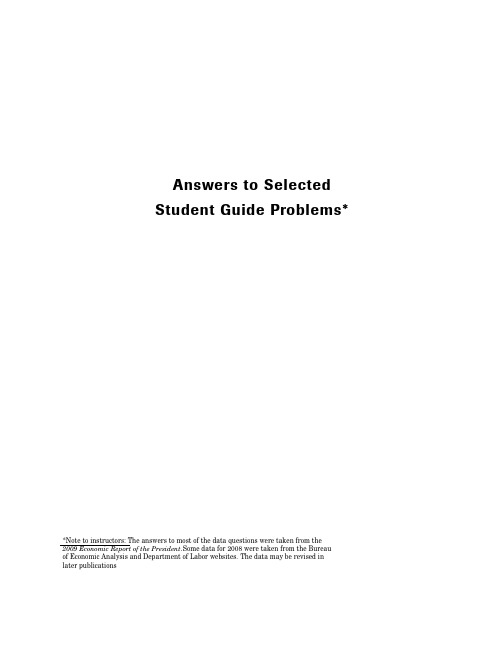
22.2 19.3 16.7
b. U.S. real GDP per capita grew the fastest from 1978 to 1988; it grew the slowest from 1998 to 2008.
4. a. and c.
Table 2–10
(1) Year
(2)
(3)
Answers to Selected Student Guide Problems*
*Note to instructors: The answers to most of the data questions were taken from the 2009 Economic Report of the President.Some data for 2008 were taken from the Bureau of Economic Analysis and Department of Labor websites. The data may be revised in later publications
11,652
13,808 3.3
14,265
b. 3.3
4 C H A P T E R
Money and Inflation
Problems
10. a.
b.
c. d. e.
The costs of expected inflation are the shoeleather costs of inflation, the menu costs of changing prices, the cost of unindexed taxes, the cost of greater variability in prices, and the costs to people who receive incomes fixed in nominal terms (such as private pensions) that were contracted before the inflation was expected.
曼昆宏观经济学第七版课后答案

曼昆宏观经济学第七版课后答案【篇一:曼昆《宏观经济学》(第6、7版)课后习题详解(第1章宏观经济学科学)】txt>第1篇导言课后习题详解跨考网独家整理最全经济学考研真题,经济学考研课后习题解析资料库,您可以在这里查阅历年经济学考研真题,经济学考研课后习题,经济学考研参考书等内容,更有跨考考研历年辅导的经济学学哥学姐的经济学考研经验,从前辈中获得的经验对初学者来说是宝贵的财富,这或许能帮你少走弯路,躲开一些陷阱。
以下内容为跨考网独家整理,如您还需更多考研资料,可选择经济学一对一在线咨询进行咨询。
一、概念题1.宏观经济学(macroeconomics)答:宏观经济学与微观经济学相对,是一种现代的经济分析方法。
它以国民经济总体作为考察对象,研究经济生活中有关总量的决定与变动,解释失业、通货膨胀、经济增长与波动、国际收支及汇率的决定与变动等经济中的宏观整体问题,所以又称之为总量经济学。
宏观经济学的中心和基础是总需求—总供给模型。
具体来说,宏观经济学主要包括总需求理论、总供给理论、失业与通货膨胀理论、经济增长与经济周期理论、开放经济理论、宏观经济政策等内容。
对宏观经济问题进行分析与研究的历史十分悠久,但现代意义上的宏观经济学直到20世纪30年代才得以形成和发展起来。
现代宏观经济学诞生的标志是凯恩斯于1936年出版的《就业、利息和货币通论》。
宏观经济学在20世纪30年代奠定基础,二战后逐步走向成熟并得到广泛应用,20世纪60年代后的“滞胀”问题使凯恩斯主义的统治地位受到严重挑战并形成了货币主义、供给学派、理性预期等学派对立争论的局面,20世纪90年代新凯恩斯主义的形成又使国家干预思想占据主流。
宏观经济学是当代发展最为迅猛,应用最为广泛,因而也是最为重要的经济学学科。
2.实际gdp(real gdp)答:实际gdp指用以前某一年的价格作为基期的价格计算出来的当年全部最终产品的市场价值。
它衡量在两个不同时期经济中的产品产量变化,以相同的价格或不变金额来计算两个时期所生产的所有产品的价值。
宏观经济学曼昆第七版第3章(2013,修正后)

经济学院经济系
戴天仕2013
3.2 国民收入如何分配给生产要素
本问题的答案:
国民收入的分配由要素价格决定,而要素价格 取决于要素的边际产出。 注:企业为了获得生产要素必须支付租金,而 家庭通过出让生产要素获得报酬。因此,拥有的生 产要素数量和生产要素的价格决定了家庭的收入水 平。本小结只分析产出在要素之间的分配,但我们 知道背后是产出在一个个家庭中的分配。
在劳动投入不变的情况下,增加一单位资本所得 到的额外产量。
14
经济学院经济系
戴天仕2013
企业增加一单位资本的收益 P × MPK 企业增加一单位资本的成本 R 在最优状态时,增加一单位资本的收益应 该等于成本: P × MPK = R
注:与劳动需求的分析基本一样。
经济学院经济系
15
戴天仕2013
人们为什么要购买生产出来的东西?
本节分别从以下角度回答这一问题:
消费(C) 投资(I) 政府购买(G)
Y = C + I + G
注:为了简化分析,我们暂时不考虑净出口。 因此,我们说本章分析的是封闭经济。
经济学院经济系
29
戴天仕2013
消费
家庭如何决定消费多少?
一般认为私人消费取决于税后收入,即可支配收 入。可用下式表达
34
经济学院经济系
戴天仕2013
为简化分析过程,本章将投资收益率视为外生 给定,假设投资需求只取决于利率。
I = I (r )
其中,I是投资,I( )是一个减函数,r是实际利 率,即名义利率经通货膨胀调整后的利率。
为了简化下文的叙述,我们定义两个变量
实际工资:W/P 资本的实际租赁价格:R/P 根据上文分析,有:
宏观经济学第七版答案曼昆
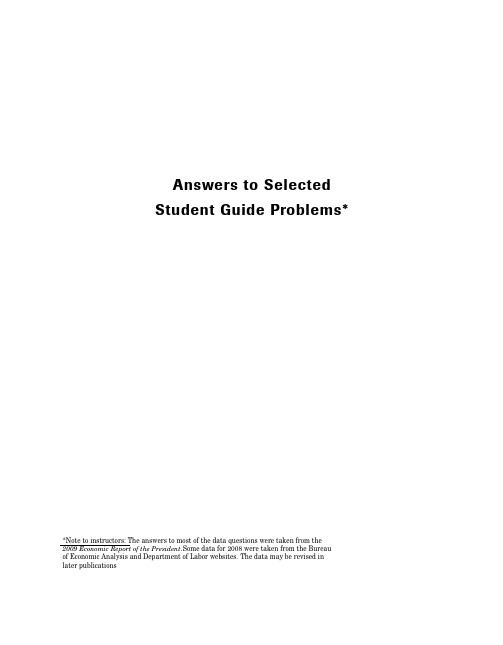
(5) % Change in Real GDP per Capita from Preceding Decade
1978 1988 1998 2008
5,015 6,743 9,067 11,652
222.6 245.0 276.1 304.1
$22,530 $27,522 $32,840 $38,316
π = % Change in M – 34% per decade.
If we use M1 as our measure of the money supply, the simple quantity theory predicts 10-year inflation rates of 86.4 percent from 1978 to 1988; 5.3 percent from 1988 to 1998, and 11.6 percent from 1998 to 2008.
C h a p t e r 4 Money and Inflation
205
Data Questions
1. a. Table 4–9
(1)
(2)
Year
CPI All Items
1978 65.2
1988 118.3
1998 163.0
2008 215.3
(3)
(4)
(5)
Consumer Price Indices
(5) % Change in GDP Deflator from Preceding Year
2007
207.34
3.8
2008
215.30
119.82 2.2
122.50
b. Imported oil is not part of U.S. GDP. Therefore, it is not included in the calculation of the GDP deflator, although it is included in the calculation of the CPI when it is purchased by consumers. Because the United States imports, rather than produces, a large portion of the oil households consume, the oil price increase had a greater effect on the CPI than on the GDP deflator from 2007 to 2008.
- 1、下载文档前请自行甄别文档内容的完整性,平台不提供额外的编辑、内容补充、找答案等附加服务。
- 2、"仅部分预览"的文档,不可在线预览部分如存在完整性等问题,可反馈申请退款(可完整预览的文档不适用该条件!)。
- 3、如文档侵犯您的权益,请联系客服反馈,我们会尽快为您处理(人工客服工作时间:9:00-18:30)。
11
Chapter 3 National Income: Where It Comes From and Where It Goes 21 If consumption depends on the interest rate, then these conclusions about fiscal policy are modified somewhat. If consumption depends on the interest rate, then so does saving. The higher the interest rate, the greater the return to saving. Hence, it seems reasonable to think that an increase in the interest rate might increase saving and reduce consumption. Figure 3–6 shows saving as an increasing function of the interest rate. r S(r Figure 3–6 Real interest rate S Saving Consider what happens when government purchases increase. At any given level of the interest rate, national saving falls by the change in government purchases, as shown in Figure 3–7. The figure shows that if the saving function slopes upward, investment falls by less than the amount that government purchases rises by; this happens because consumption falls and saving increases in response to the higher interest rate. Hence, the more responsive consumption is to the interest rate, the less government purchases crowd out investment. r S2(r S1(r Figure 3–7 Real interest rate r1 r ∆G I(r I1 I
I, S Investment, Saving 13. a. Figure 3–8 shows the case where the demand for loanable funds is stable but the supply of funds (the saving schedule fluctuates perhaps reflecting temporary shocks to income, changes in government spending, or changes in consumer confidence. In this case, when interest rates fall, investment rises; when interest rates rise, investment falls. We would expect a negative correlation between investment and interest rates.
22 Answers to Textbook Questions and Problems S1 (r r S2 (r Figure 3–8 Real interest rate I(r I, S Investment, Saving b. Figure 3-9 shows the case where the supply of loanable funds (saving does not respond to the interest rate. Also suppose that this curve is stable, whereas the demand for loanable funds varies, perhaps reflecting fluctuations in firms’ expectations about the marginal product of capital. We would now fin d a positive correlation between investment and the interest rate—when demand for funds rises, this pushes up the interest rate, so we see investment increase and the real interest rate increase at the same time. r S(r Figure 3–9 Real interest rate I 2 (r I 1 (r I, S Investment, Saving
Chapter 3 National Income: Where It Comes From and Where It Goes 23 c. If both curves shift, we might generate a scatter plot as in Figure 3–10, where the economy fluctuates among points A, B, C, and D. Depending on how often the economy is at each of these points, we might find little clear relationship between investment and interest rates. r S1 (r S2 (r D Real interest rate C A Figure 3–10 B I 1 (r I 2 (r I, S Investment, Saving d. Situation (c seems fairly reasonable—both the supply of and demand for loanable funds fluctuate over time in response to changes in the economy.。
